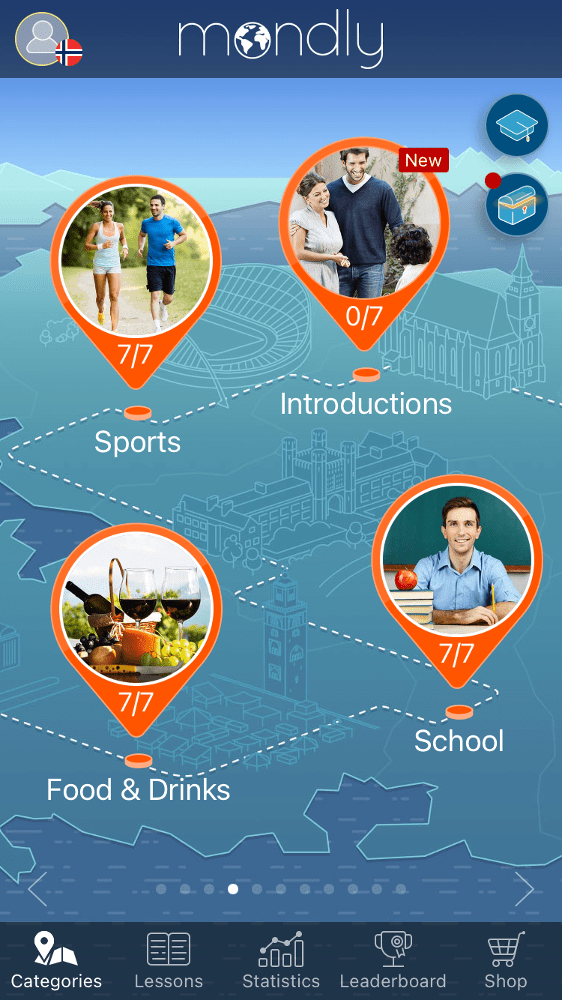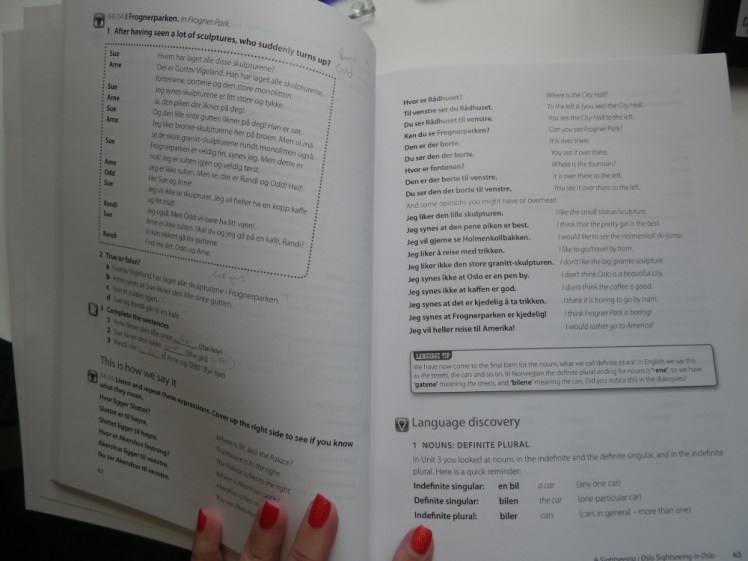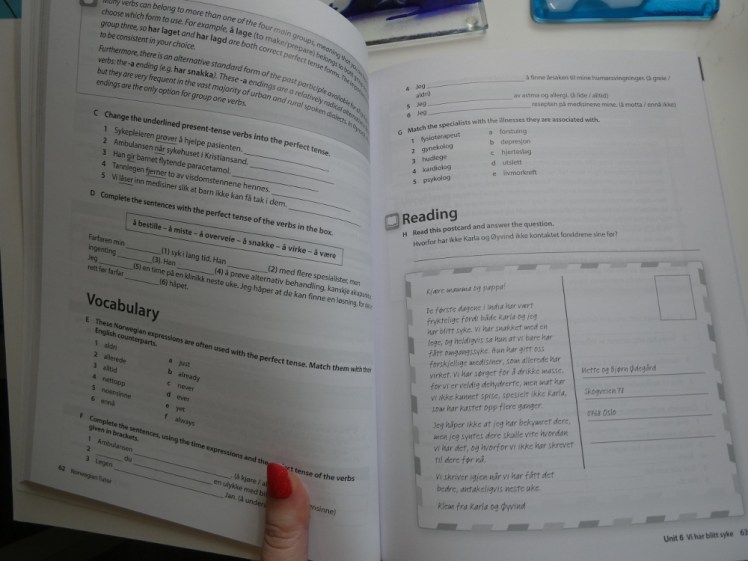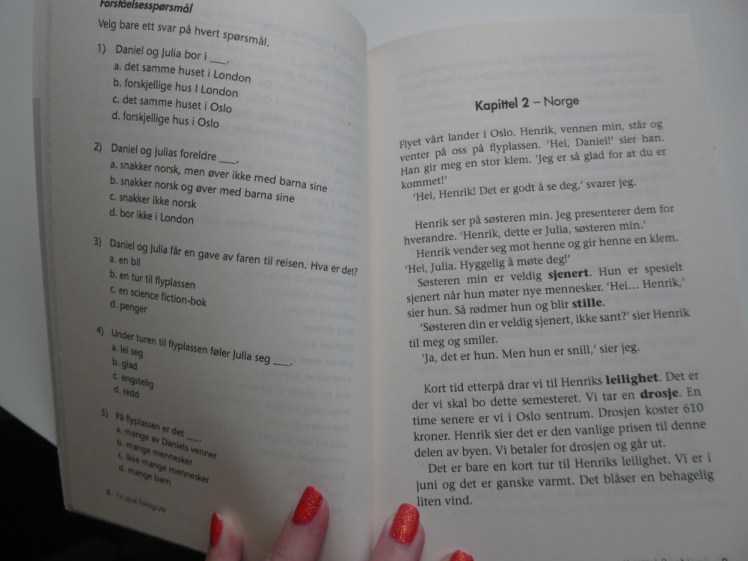I thought I’d do a post about my Norwegian learning resources. I’ve been doing it on and off since about the end of 2016 but it’s only in Lockdown Three that I’ve really started taking it seriously. It’s been what, a month, and I’ve been introduced to three tenses already that I’d never even seen in the previous four years of casual learning and an entire set of bewildering adjective agreements. I plan to do a post later on in the year about my progress and my thoughts on learning a Scandinavian language but it seemed it might not be a bad idea to do a post about my Norwegian learning resources.
(Any book links in this post are non-Amazon affiliate links to bookshop.org, which supports independent bookshops.)

Oh, of course Duolingo! Who hasn’t thought about learning a language and gone off to the world’s most popular language app? Duo will start you off with nonsense sentences about mice not reading newspapers and women having the strawberries and you’ll spend forever repeating “I am a woman. I am a man. I am not a man. I am a girl. She is a woman” but you’ll pick up more than you realise. I find Duolingo is very short on the grammar – you’ll learn something and then suddenly it’ll change and it won’t tell you why but on the other hand, when you learnt your native language as a small baby, no one taught you grammar either. On one of my other resources, I’m currently watching a teacher try to explain “V2 structure”, which means that the verb comes in the second position – he’s finding it almost impossible to explain to newcomers what “second position” actually means but I’m finding that I almost instinctively understand just from context, having repeated thousands of weird little sentences from Duo before taking on real grammar.
Duolingo is free and it’s easily accessible and it has a lot of languages and while it’s far from perfect, it’s probably the best and definitely the most popular language-learning medium out there at the moment.
Speaking: 7/10
Grammar: 3/10
Vocab: 7/10
Total: 17/30

I think Mondly is what got me really going in Norwegian. I suppose it operates in a similar way but instead of grinding nonsense sentences into you that nonetheless give you a grasp of how the language works, it teaches you usable sentences for going to and living in Norway. I’ve been paying a subscription to it, which I presume is because the free version is so limited although it’s been so long since I used the free version that I can’t remember. I might recommend subscribing for the first couple of months, to get you speaking the basics pretty quickly but I wouldn’t bother after that. If you’ve got Duolingo and you’ve got a few sentences, it’s not really worth paying for anymore.
Speaking: 7/10
Grammar: 3/10
Vocab: 8/10
Total: 18/30

Futurelearn is a site with a reasonably wide array of online courses, ranging from “learn to play jazz piano” to “international culture and tourism management” to “data analytics using Python” up to “learn Norwegian”. There’s “introduction to” several languages but the only ones it really any further into are Irish and Norwegian. I’m doing Introduction to Norwegian and in March Introduction to Norwegian 2 starts – these are the University of Oslo courses. There are also three Norwegian for Beginners with the Norwegian University of Science and Technology.
The Oslo Uni courses follow a little group of international students. You watch videos with them, then you answer questions on the videos. They introduce a page of grammar and you answer questions on that, then Harald and Teodor teach you phonetics – listen and repeat – and then you either have a listening exercise where you fill in the missing word or the lead educator attempts to explain problems he’s spotted in the comments along the way. There are eight course days split into four weeks but as they all become accessible on the day the course begins, and it remains accessible for about six weeks, you can do it at whatever speed suits you. I daresay Norwegian 2 will follow a similar pattern.
Now, Futurelearn is free but if you want permanent access to the course, or if you want a real (digital) certificate of achievement, you have to pay for their upgraded or ultimate version, which I’m not going to do. It can’t beat a real in-person Norwegian course but the Norwegian courses are thin on the ground in my part of the world, and I haven’t found anything else that’s teaching in this way, or bothering with phonics. However, give or take the quizzes, the written part of it is mostly “leave your sentence in the comments for your fellow learners to comment on” and that’s not really my thing.
Speaking: 6/10
Grammar: 6/10
Vocab: 8/10
Total: 20/30
Teach Yourself Complete Norwegian (and Enjoy Norwegian)


I hadn’t realised how big the Teach Yourself system is until I made myself a languages shelf and realised how many of my books have that little yellow box on them. Dating back to my uni days, I have big plastic boxes containing a coursebook of exercises without imagination and a CD in a plastic case containing the audio. Of the three sets (well, I have no CD with the Welsh book), the only one I’ve done anything with is the first chapter of Welsh.
But fast-forward fifteen years and the Norwegian book is a bit different. The first one, beginner to intermediate, is called Complete Norwegian and the second one, intermediate to upper intermediate, is called Enjoy Norwegian. Those are not very user-friendly titles to help you figure out which one you should be going for. I’d have included words like 1 and 2 or Beginner and Intermediate, or anything to signpost you in the direction of the right book for your level. I own both but I’m currently working on Complete Norwegian.
It’s a big shiny book full of reading and listening exercises and the audio is now free to stream online so no need to search out a CD player. It’s a lot like the textbook you had for French at school, except I’m writing directly onto the pages (in pencil so I can rub them out if I ever want to start again) and instead of a qualified teacher, I’m teaching myself with the aid of the online audio. It’s a good second to Futurelearn – it doesn’t have any videos and it doesn’t have any phonetics but it seems to be teaching usable stuff about travelling and tourism alongside going deeper into the grammar than Futurelearn has time for and I daresay the topics will turn later into better and broader Norwegian rather than quickly-usable tourist Norwegian, which is probably what most people want in the beginning.
It’s the first resource I’ve used that’s actually explained how adjectives work – I’m familiar with the concept of adjective agreements from my Romance languages but obviously Norwegian works differently so I’ve spent a while struggling with that. Duolingo expects you to realise why it’s sometimes stor and sometimes stort and sometimes store and Futurelearn hasn’t touched on adjective agreements or noun genders at all.
Speaking: 4/10
Grammar: 8/10
Vocab: 8/10
Total: 20/30


The next of my Norwegian learning resources is another book from the Teach Yourself system and it’s a grammar and vocabulary workbook. I haven’t used it yet because it’s “advanced beginner to upper intermediate” so I’m thinking I’ll start when I’m halfway through Complete Norwegian. But it looks like it’s really going to explain and drill into me the grammar, complete with a lot of exercises and I think that’ll be a good complement to all the language learning that focuses on speaking rather than the technicalities.
Speaking: 3/10 (est.)
Grammar: 10/10 (est.)
Vocab: 6/10 (est.)
Total: 19/30
Norwegian Verbs and Essentials of Grammar


I bought this book back when Duolingo wasn’t explaining possessive pronouns to me properly. Unfortunately, I find this is bit dry and heavy and not learner-friendly at all, and when I’d stared blankly at the pronouns page, I went off to YouTube in the hope of finding someone who could explain in real words. I like having it as a reference but I’m not finding it’s actually of much use to me.
Speaking: 1/10
Grammar: 3/10 (est.)
Vocab: 2/10 (est.)
Total: 5/30


Yet another Teach Yourself book. This is a book of nine or ten stories in Norwegian, meant for “high beginners to low-intermediate” learners, which is why I haven’t started this one either. The short stories are broken down into chapters and at the end of each chapter is a vocab list and a few basic comprehension questions. The idea is to read even if you don’t understand every word, enough to get the gist, do the post-chapter reading and then give it another go. That way you get comfortable reading in a new language and get to see that language used in a more natural way than you’ve experienced it in your textbooks or your app. I really like the idea of this, when I’m a bit further on in my basic skills.
Speaking: 1/10 (est.)
Grammar: 6/10 (est.)
Vocab: 9/10 (est.)
Total: 16/30
Harry Potter og de Vises Stein

I had the idea of reading books long before I discovered Short Stores In. This is the Norwegian translation of Harry Potter & the Philosopher’s Stone. I have it on Kindle but the first thing I’m going to do when I’m allowed to go to Norway is get a paperback copy. I just think it’ll be so much easier if I can keep a bookmark in it with a list of the magical words – for this is the major problem. I first read this book in English in 1999 and I’ve read it every year or two since. I can virtually recite it in my sleep. That helps a lot with reading it in Norwegian, except it’s mixing a language I don’t know very well with Norwegian translations of magical words. Dumbledore, Hogwarts, Quidditch, Gryffindor – you wouldn’t think they need to change, given that they’re not English words, but they do. I’ve stumbled through about half of this, but it was a while ago. Even so, I was amazed how far I could follow it. You don’t need much grammar, honestly. If you can recognise a verb in the present, you can probably recognise it in the past and the conditional. It’s not enough to write or possibly even speak, but it’s enough to read a book you already know well.
Speaking: 1/10
Grammar: 5/10
Vocab: 9/10
Total: 15/30
Phrasebooks

For Secret Santa, on two different years, I acquired a European phrasebook and a Scandinavian phrasebook and they were among my earliest learning resources, because they’re full of words and phrases that you might actually use. The problem is, and the reason I turned to Mondly and Duolingo, that they don’t actually teach you how to pronounce the words. They give you a phonetic pronunciation but of course, that depends on the accent of the person who wrote it and the accent of the person reading it (let’s take “chance” as spoken by a southern Englander like myself. I’ve seen Americans reproduce that phonetically as “chonce”, whereas I’d spell it something more along the lines of “chahnce” and some people who are obsessed with rrrr would spell it “charnce”. Those latter people are horribly wrong. There’s no rrr in southern English vowels).
I stick by phrasebooks being useful for vocabulary but you need to have an idea of how to say the new words.
Speaking: 2/10
Grammar: 2/10
Vocab: 6/10
Total: 10/30
I think that’s everything. You see why I have a dedicated language shelf – the Norwegian is the only one that I’m taking seriously and have an actual library for but I have so many other bits and pieces for French, Spanish, Catalan, Icelandic, Russian, Irish, Welsh, German, Italian, Greek and Polish – some, admittedly, courtesy of my parents who bought some phrasebooks for holidays before I was born or when I was tiny. I even have First Hundred Words In French that they bought for me to read in the car on holiday when I was five or six.